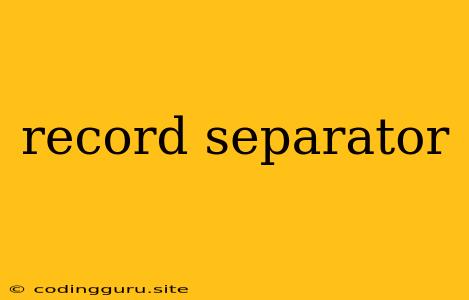Understanding Record Separators: A Crucial Element in Data Handling
In the realm of data processing, particularly when dealing with large datasets, the concept of a record separator plays a crucial role. It's a seemingly small, often overlooked detail that governs how data is organized and interpreted. Understanding record separators and their significance is vital for efficient data manipulation and analysis.
What is a Record Separator?
Think of a record separator as a special character or sequence of characters that acts as a delimiter, indicating the end of one data record and the start of another. Imagine a file containing information about various products, with each product's details forming a single record. The record separator acts as a dividing line between these records, allowing the data to be parsed and processed effectively.
The Need for Record Separators
Record separators are essential for several reasons:
- Organization: They structure data into meaningful units, making it easier to read, process, and analyze.
- Data Integrity: They ensure that individual records are not merged or corrupted, preserving the integrity of the data.
- Flexibility: They allow different data formats to be utilized, as the specific record separator can be defined according to the requirements.
Common Record Separators
While the choice of record separator can vary depending on the application, certain characters are widely used:
- Carriage Return (CR): Often represented as
\r, used in older operating systems like Mac OS 9. - Line Feed (LF): Represented as
\n, commonly used in Unix-based systems. - Carriage Return and Line Feed (CRLF): Represented as
\r\n, used in Windows operating systems. - Semicolon (;): A common record separator in CSV files.
- Pipe (|): Often employed in data exchange formats.
Identifying and Using Record Separators
Identifying the appropriate record separator is crucial for successful data processing:
- Examine the File Structure: Analyze the data file to identify the character or sequence that separates individual records.
- Software Tools: Many text editors and data processing tools provide options to define and visualize record separators.
- Documentation: Check the documentation of the software or data source to determine the specific record separator used.
Programming with Record Separators
Record separators are often used within programming languages to parse and manipulate data. Let's explore a simple example in Python:
data = "Product 1;10.99;In Stock\r\nProduct 2;19.99;Out of Stock\r\nProduct 3;5.99;In Stock"
record_separator = "\r\n" # Using CRLF as the separator
products = data.split(record_separator)
for product in products:
name, price, stock = product.split(";")
print(f"Product Name: {name}, Price: {price}, Stock: {stock}")
This code demonstrates how to split data based on the record separator (\r\n) and extract individual product information.
Conclusion
Understanding record separators is a fundamental aspect of data handling. These seemingly simple characters play a crucial role in structuring, separating, and interpreting data, ensuring efficient processing and accurate analysis. By understanding the different types of record separators and how they are used, you can effectively manipulate and extract valuable insights from data.
